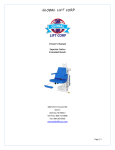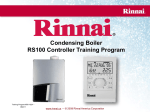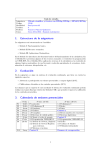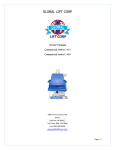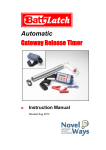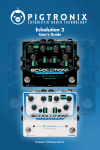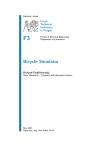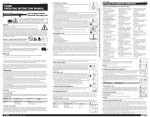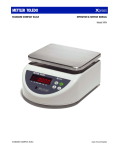Download SIDEWALK REPAIR MANUAL How to Repair and
Transcript
SIDEWALK REPAIR MANUAL Today, you can actually put diamond to work ……. ....... Making your sidewalks safer and more accessible ……. Repair your Sidewalks with Pre-Emptive Grinding! By: Sidewalk Savers, Ltd. Http://www.SidewalkSaver.com How to Repair and Maintain a Sidewalk. © Copyright 2007 Sidewalk Savers, Ltd., All Rights Reserved. Be sure to visit: http://sidewalksaver.com/blog1/ Sidewalk Savers Ltd. 886 East College Ave Westerville OH 43081-2505 USA Ph. 1.614.882.0499 www.sidewalksaver.com INTRODUCTION We are becoming increasingly aware of the need to maintain our infrastructure and to assure the safety of people who are traveling past our homes, our apartment buildings, our retail stores, schools, parks, and a wide array of public and private sector walkways. Sidewalk Savers LLC was created specifically to promote an alternative, low cost, highly effective method for maintaining and for repairing our concrete sidewalks in a timely manner. Concrete Sidewalks have the major advantage of being impervious surfaces which require a minimal amount of care. Unfortunately, however, the ground beneath the concrete periodically shifts due to erosion or simply settling of the ground beneath the concrete. Another natural phenomenon is the growth of tree roots beneath the concrete blocks causing them to rise or crack. As one concrete block cracks or moves relative to another block, corrective adjustments will periodically need to be made, even with newly installed sidewalk blocks. The key is to monitor the changes on a regular basis and to implement minor corrections quickly as they become necessary. The purpose of this manual is to outline the Sidewalk Savers methods that will expand the simple, convenient preventative maintenance procedures that eliminate problems before they become dangers to sighted and blind walkers and before they become impossible barriers to wheelchair riding neighbors. Confronting the small problems immediately with low cost diamond grinding tools prevent the problems from becoming so bad that they present serious dangers that only Removal & Replacement methods can resolve, at least until the cycle starts all over again. The simple pre-emptive grinding solutions proposed in this Manual will help homeowners, taxpayers, and other organizations to save money for the more news-worthy projects such as repairing our bridges and the adjoining roadways. Why Maintain Sidewalks? Many people tend to overlook sidewalks or to even consider them as unnecessary in this modern day America where automotive transportation has become the way of life. The fast paced Soccer Mom transportation systems have replaced the slower paced world of the early 20th century where school children would play in their own neighborhoods or where people would commute by street cars or trains and walk the last mile to their homes on a sidewalk. So why should we maintain or even have sidewalks at all? 2 One of the best reasons for sidewalks to even exist in today’s suburban neighborhoods is to get neighbors away from their computers and television sets and out into the neighborhoods to simply know what is going on around them. Quite simply, it is a matter of security and safety for us to walk up and down the sidewalks and around the block to meet our neighbors, perhaps to even go to a store, a church, a synagogue, or even visit friends and relatives if you are lucky enough to have some living within walking distance. Of course the fact that a little bit of exercise will not kill us is an added plus. Recognizing the advantages of sidewalks in our neighborhoods is the first step toward appreciating why we ourselves will want to do whatever is necessary to make our own small portion of the neighborhood sidewalk system be clear and safe to invite others to pass in safety. What are the typical failure modes for Sidewalks? This manual addresses the normal and customary ways that sidewalks wear with special emphasis on those failure modes that our relatively simple Diamond Tools and procedures can help a homeowner, a maintenance person, or a contractor to repair with minimal training and with minimal expense. 1. 2. 3. 4. 5. Shifting Blocks. Cracks Spalling General disintegration or crumbling. The desire to convert standard Concrete to Decorative Concrete. The first 2 of these are quite likely within the scope of this manual and solvable by diamond grinding or cutting. The 3rd item can possibly be helped by some variation of grinding and filling, and the 4th is simply a remove & replace application, depending on the severity and the area involved. Item number 5 is not really a failure mode at all. It is better described as a “Failure to please” you or your significant other. This is a case where perhaps you choose to expose the beautiful aggregate by grinding the entire patio or perhaps the pool area to give a beautiful exposed aggregate appearance. This is actually an application that can be within the scope of this manual depending on the conditions existing currently, what you want to achieve, and the size of the area needing to be treated. 3 SHIFTING BLOCKS: Preliminary Check to Assess the Trip Hazards The first step is simply to go for a walk up the street in front of your house or around the block. Check the number of potential trip hazards that you encounter. If you really want to notice the stumbling points and barriers, you can test your skills at in-line skating, or pushing a baby stroller, or perhaps the very daring could even ride a wheel chair. Even the 1/4" bumps will be instantly noticed and these 1/4" bumps are frequently encountered on even the newest sidewalks. Measurements and Calculations. Figure 1: Oregon, OH depiction of compound angle grinding. 1) Measure the Hazard and determine what is required to correct it. · 0-1/4" Step is generally ignored but can be easily beveled at the same angle as the 1/4”-1/2” steps. · 1/4" - 1/2" Steps are ground with a 1:2 Ratio so that a gradual transition from 1 / 2" to 1" in length is ground on the surface depending on the actual measurements. · 1/2" - 1" Steps are treated as a “Ramp” in accordance with the recommended standards of the Access board in Washington, D.C. This requires that they be ground with a 1:12 Ratio so that a gradual transition from 6" to 12" in length is ground on the surface of the sidewalk block. 4 HINT: The City of Portland, Oregon has a “Citizen Sidewalk Repair Manual” available in which they recommend a 1:12 ratio for all grinding in the ¼” – 1” range. This makes the job look better and it makes the calculations quick and easy: STEP 1 / 4” 1 / 2” 3 / 4” 1” Ramp Length Î 3” long ramp Î 6” long ramp Î 9” long ramp Î 12” long ramp Figure 2: Portland, OR’s Sidewalk Repair Manual shows “before” and “after”. 2) Tools and methods for measurement. Calculations and marking. 1. General method: A simple board can be placed on top of the higher sidewalk block so that the distance from the bottom of the board down to the lower sidewalk block can be measured and recorded. If the measurement is taken from the top of the board to the top of the lower sidewalk block, it is necessary to subtract the thickness of the board. 2. By using the Step Height, calculate the Ramp Length of slope as mentioned above. 3. Mark the Ramp Length on the higher block with a permanent marker. 4. Repeat this process at increments across the width of the sidewalk. Typically, measurements at 3 4 points across the Sidewalk Block will be sufficient to indicate if a straight Ramp or a combination Slope ramp needs to be ground. 5. Connect the Dots to show the length of Ramp which will be ground. 5 3) Tools and Equipment to minimize the need for grinding. · BLOCK Re-Alignment: Some of the first applications you will “encounter”, will be a block which is 2”, 3” or more as these are typically caused by long ignored tree roots. These will generally not be candidates for correction by Grinding, but there will be some cases where the individual blocks are in perfect condition with the dislocation being the only problem. · For large driveway sections, the lower block is frequently raised by a process referred to as “mud jacking” or “slab jacking”. This process involves the use of a diamond Core Drill Bit to drill strategically placed holes so that a slurry can be pumped under the block to hydraulically lift it to be level with the adjoining block. This procedure requires additional equipment and procedures which are beyond the scope of this “Sidewalk Savers” system so we would recommend qualified Contractors to perform such a “Mud-Jacking” service. · For SIDEWALKS or Garden walks, on the other hand, the blocks would be inspected for cracks or other signs of damage. No cracks? Block Intact? …… then you are ready to consider the next step. The sidewalk is then checked to see that the blocks are separated at the joints. If not, then a diamond saw blade can easily separate the blocks so that one can be lifted at a time. · HINT: Even if the blocks are separate, it is useful to run a Diamond Saw Blade through the crack to eliminate any interference points between the two adjacent blocks. · · The sidewalk blocks are now ready to be brought into alignment by using one or two of the 5 foot pry bars for lifting the lower of the two blocks to be nearly the level of the adjoining block. For this operation, the area beneath the block can be back-filled to support the block in its new position by using wooden dowel rods. The more completely the cavity beneath the raised block is filled, the better. BUT, it is important to avoid raising the block more than ¼” above the adjoining block or you will have created a new step hazard in the opposite direction. Î NOTE: It is critical that you avoid placing fingers, feet, or other body parts under the raised block. · The nearly level joint is now ready for grinding as mentioned in the following section to finish the repair. One Caveat with this procedure: If the Sidewalk Block cracks, then Replacement may be the only option, so this process must be approved by the Property owner and the Inspector before implementing it on the sidewalk. It is most frequently applied to garden walks. · 6 4) Grinding Methods: Bevel Edges. • A simple 1:2 Bevel, for repairing the 1 / 4” – 1 / 2” step, can be ground by using the Single row diamond Cup on the Jepson 4.5” angle Grinder. This process can be sped up significantly by using the “Grizzly 7” Single row diamond Cup on the heavy duty Makita GA7911 Sander, but this may not be necessary for the DIY home-owner where tool cost is more important than is the time required for completing the task. Grinding a Slope. • A 1:12 Ramp , for repairing the 1/2” – 1” step, can be ground by using the hungry “Grizzly 7” Single row diamond Cup on the 7” angle Grinder. For those who are preferring to produce a 1:12 ramp on the 1/4” – 1/2” steps, they will still be operating within the capabilities of the smaller 4.5” diamond Cup and grinder which was used for the bevel edge, but once you have used the “Grizzly 7” you will tend to use it for everything. • Squaring the Grind: The final step in grinding a “Site” is to square up the Ramp by making the ground surface end in a line which is perpendicular to the edge of the sidewalk. The Color of the overall concrete walk can be enhanced by Power Washing at the end of the Grind, but this is usually considered as an Extra Cost option. • Grinding Machine and the “ Grizzly 7” Diamond Cup : 7 CRACKS in SIDEWALK BLOCKS: Crack Sealing - Basic Method with Epoxy Based Patch Material: • A simple crack in a garden walk, a sidewalk, a driveway, or even a Basement or Garage floor where dislocation is not yet evident, can sometimes be repaired by patching with a suitable Portland cement or epoxy based patching material. The key to successful patching is the Crack preparation which can frequently be accomplished with a 4.5” Crack Sealer Wheel on a 4-5” Angle Grinder. This Crack Sealer Wheel or the more aggressive Crack Sealer Segment Blade carves a Vee Groove where previously there was a crack. The ½” width Vee Groove is typically ½” to ¾” deep so that the Epoxy based patch material has a better opportunity to grip and produce a long lived smooth patch. The added benefit of this type of timely patch is that it prevents water seepage and can prevent the shifting or separation which would occur with an un-patched surface. Driveway Apron with qualifying Crack where there is no dislocation of either section. Î Crack Sealer Blade with Dust Muzzle. Î 8 • The method as listed above works well when you are using an Epoxy Based Concrete Patching material, but the availability and the cost for the patching material could be an issue, especially for a home-owner who is looking to save money and would prefer to be a little creative. In such a case, the repair can be accomplished by using low cost Portland cement based concrete if a slight variation of the grinding process is implemented. Several such variations are described below. Of course, if these alternate methods prove to be unsuccessful for your particular application, you can always use the Epoxy Base Patch method as your fall-back position. Alternate 1: Crack Repair with Low Cost Portland Cement Patching Materials: • After widening the Groove with the Crack Sealer Blade, the next step involves a 4.5” or perhaps a 5” diamond Saw Blade used sequentially at an appropriate angle to widen the base of the crack to be wider than the top of the crack. (An Inverted V.) The rougher the surface at the bottom of the crack, the better it is for mechanically holding the Portland cement patch. Î NOTE: The object is to make sure that the bottom of the crack is wider than the top so that the cured patch will be mechanically as well as chemically held securely in the repaired crack. • • The crack is then cleaned thoroughly to remove any dust and the newly exposed surfaces are thoroughly washed and soaked but without leaving standing puddles in the crack. Depending on the location of the ends of the crack, it may be necessary to block the ends of the crack to hold the Concrete patch material in place during set-up. This is accomplished by placing a small thin wood board at each end of the crack. • A concrete bonding adhesive is then used to paint the sides and bottom of the “inverted V” groove to achieve bonding. Follow the manufacturer’s recommendations for applying the specific adhesive and for waiting until the adhesive becomes tacky before applying the concrete patch material. A good Grade of Concrete Bonding Adhesive, such as Quikrete No. 9902, enhances the chemical bonding of the Portland Cement Concrete mix with the existing concrete. • Apply the Concrete patch to the prepared crack using a trowel and press the patch material firmly into the crack, being sure to fill all voids, remembering that the bottom of the crack is wider than the top. Smooth the patch and allow it to dry for several hours, 9 • periodically applying a light spray of water and covering the crack with a plastic material to slow down the drying process. Continue to dampen the patch at least 1 or 2 times per day while continuing to keep the patch covered with the plastic for 4-5 days. At the end of the fifth day, the plastic can be removed and the concrete will continue to cure. Alternate 2: Patching Thin Hairline Cracks where there is no shifting of the block segments: • • • The thin hairline cracks may be patched by using a simple Straight Sided Diamond Saw Blade to chase the crack, slightly opening the crack, widening the bottom of the crack more than the top, but producing a narrow top opening in comparison to what has previously been discussed. The 5” Diamond Saw Blade can be used with the 5” Dust Muzzle to reach down to the bottom of the Crack while being canted to expand one side of the bottom and then the other side at the bottom of the crack. Ideally, this can be done with minimal widening of the top of the crack. The Crack is cleaned thoroughly, just as before, and then the crack is painted with the same concrete bonding adhesive material, waiting the prescribed period of time to allow it to become tacky. The actual Concrete Patch for this thin crack method needs to be a Sand Mix with no Gravel in order to assure that the patch does actually fit into the opening and spread to fill in the bottom. If only a gravel mix of concrete is available, it may be necessary to strain the Concrete Mix through a screen to eliminate the coarse gravel prior to preparing the Concrete Patch for insertion into the crack. Safety and Dust Control: One of the major concerns for safety when grinding or sawing concrete is Dust Control, right after the common sense cautions that are necessary to keep cutting tools from cutting or slicing body parts. The Dust Muzzle II and Fine Particle Vacuum System can capture up to 95% of the dust at the point of origin, giving the other recommended safety equipment a chance to effectively protect the operator from Silica Dust inhalation. We have found our Loveless Ash Wet-Dry Shop Vacuum to be the best and most cost-effective means to collect the fine particle Dry Dust without clogging. The triple Filtration system, including the internal PreFilter bag is excellent for collecting the fine Silica Dust that is produced when grinding or cutting Concrete. A properly installed Pre-Filter Bag will keep the dust from reaching the internal second and third stage filters for reasonable periods of time, unlike Vacuums without such a pre-filter bag. Preventing the dust from reaching 10 the later stage filters has the added benefit of not blowing the dust through the vacuum and right back into the air as is common with many low cost shop vacuums. Additional features are described at our web site. NOTE: It is still necessary to wear all Safety Gear: • Respirator, • Safety Glasses, • Hearing Protection, • Gloves and • Knee Pads in order to perform these grinding and cutting applications. Estimating the Job - Multiple approaches to home in on cost. Replacement Cost -- Estimating Method: Width 5 5 5 Sidewalk Block 1 Sidewalk Block 2 Sidewalk Block 3 TOTAL COST: Length 4 5 6 Number 1 3 1 $ /ft² $8.00 $8.00 $8.00 Cost $160.00 $600.00 $240.00 $1,000.00 This Replacement Cost Method acts as a cross check on the following two methods which should produce costs which are lower by 50-60%. Length of Grind Site -- Estimating Method: Width 5 Grind Site Set-up Time Costs: TOTAL COST: • Number ● 7 $ /ft $9.75 Cost $341.25 $60.00 $401.25 Number of Joints or Sites between Blocks which need to be ground. Time & Materials -- Estimating Method: Labor Costs Tool & Materials Cost TOTAL COST: # Hours 4 $ /hour $75.00 Cost $300.00 $100.00 $400.00 11 Based on the estimated costs for this “Typical” Reference Job, it would be $400.00 to purchase or less than $100.00 for the D-I-Y homeowner who merely needed a Diamond Cup and safety equipment. The costs for a D-I-Y homeowner will primarily be tool costs depending on what tools and equipment he has on hand. Even if buying all the required equipment for the job, the D-I-Y savings would still be in the 50%-60% range. Besides, how bad can it be if he has a “Grizzly 7” Diamond Cup on the workbench ready for fine tuning the sidewalk in the years ahead? The “Grizzly 7” Diamond Cup is shown on the left. The 4.5” Single Row Diamond Cup is shown on the right. Obviously size does matter! The Grizzly 7 is a much hungrier diamond cup with coarser diamond and segment design engineered for low force fast cutting action. The perfect combination for re-defining the surface of the concrete sidewalk and for exposing the aggregate. The Coarse mesh diamond crystals are shown moving from Left to Right (as the diamond cups are Rotating Counter Clockwise) in the adjacent photo. The Diamond Crystals can be seen to look like comets with bond tails trailing behind the crystals. 12 The 4.5” Diamond Saw Blade or the Crack Sealer wheel can be used with the Dust Muzzle and Center Hub Adapter for cost effectively repairing cracked sidewalks. Business Opportunity: for Single Entrepreneur or small company. The Cost effectiveness of Grinding vs. Replacement methods creates opportunities for the qualified entrepreneur to provide this Sidewalk Saver Service™ as a service to his neighborhood and beyond. The fact of the matter is that even newly poured sidewalks frequently need “fine tuning” to make it meet the surface smoothness requirements of the A.D.A. ………. or of my Road Bicycle with the 7/8” tires inflated to 110 psi. Getting started as a small business is especially attractive since the City Sidewalk inspectors frequently provide the “Marketing Services” as they perform their annual survey of the sidewalks. The converse is equally true as the City Inspector and our web site are frequently being asked for a list of people to do the work. The representative of the City of Portland, Oregon recently commented that the contractors follow the Inspectors around and submit their cost estimates for grinding repairs at the same time as Replacement Cost estimates are being provided. Portland even goes the extra step to allow the home owner to replace a partial block when the home-owner does the work himself. They explain in their Citizen’s Sidewalk Repair Manual that this option is not available as an option if the City does the work. The periodic shortage of concrete material has made the comparisons even more favorable for grinding and for Portland’s partial block replacement. 13 Advanced Topics Surface Quality: One of the concerns about Grinding Concrete has been the quality of the surface which is produced by grinding as compared to newly poured Concrete. A set of photographs of Curb Cuts in our Spring Grove sub-division in central Ohio clearly depicts the spalling of the concrete which was poured improperly 4 years ago as opposed to the curb cut which was made with Diamond Saw Blades. Í The photo on the Left shows the spalled Curb Cut at the intersection of East College Avenue and Nicole Ave. in Westerville, OH on 26-MAR-2006. The Photos below show the Curb which was cut with Diamond Saw Blades. The location is North Hempstead at the intersection of the Towers Park Bicycle Trail on 26MAR-2006. Í Diamond Grinding and Diamond Sawing have the same effect on the Concrete surface, exposing the aggregate as clearly seen in these photographs. 14 Additional studies have been preformed by State Highway Departments over the past 30 years as Diamond Sawing and Grinding has been increasingly utilized for Highways, Airport Runways, Bridge Decks, Dams, and countless projects of concrete construction and renovation. For lists of these references, we would invite the reader to contact us at: [email protected] specifying the targeted applications. “Free Cutting” Ability: A key concern for all grinding operations is the “Free-Cutting” ability of the Diamond tool since it is most important to incorporate a Diamond/Bond/Tool Design that will cut the concrete with normal forces that are within the capabilities of the operator. A grinding cup needs to define the geometry of the cut rather than tending to follow the existing topography as the area of grinding contact increases. This is achieved by combining the Diamond type, diamond mesh size, the diamond concentration, Metal Bond Technology and relatively small contact area segment design. The Temptation to use a Longer Life Diamond Cup is frequently quite attractive, but should be avoided for operational reasons since it is unable to properly establish the desired geometry which is the reason you are grinding the concrete in the first place. A Double Row Diamond Cup would seem like a good buy since there would obviously be more diamond and the life would logically be increased. Unfortunately, this increased Surface area or harder Bond would increase the likelihood of the tool following the workpiece topography instead of creating and defining the geometry of the surface being ground to meet your specific requirements. If you see a web site that derides grinding and shows pictures of unsatisfactory grinding, it is most likely that the tools were designed for long life rather than for the Free-Cutting action that is so critical to success with this type of grinding application. Our new “Grizzly 7” Diamond cup shown on page 12 shows how we have extended this logic to produce an even faster cutting diamond Cup for repairing and maintaining concrete sidewalks. Single Row 4.5” Diamond Cup Double Row 4.5” Diamond Cup 15 POWER FOR THE JOB: One of the first things we noticed when applying the Sidewalk Saver Procedures was the need to have 2 separate 20 amp circuits in order to power the 7” Angle Grinder and the Dust Collection Systems simultaneously. Our first applications relied on plugging one heavy duty (12 gauge) extension cord into the garage outlet and plugging the other heavy duty (12 gauge) extension cord into another circuit, generally a living room circuit. As this quickly became an annoyance, I found it easier and more portable to travel with my own Generator. For my specific requirements, I chose a 5275 Running Watts, 7350 Starting Watts, emergency Generator with two 20 amp circuits. This gasoline powered generator greatly increases the flexibility to save sidewalks near parks or schools or other locations where electrical power is not available. CLEAN UP: Following the actual grinding of the sidewalk, the freshly ground surface will appear to be white in color compared to the surrounding surfaces which have been weathered and darkened. The best way to create a truly uniform surface color is to power wash the entire sidewalk following the normal grinding and clean up operations. Of course, this will be subject to having a power washer available, an adequate supply of water, and on a more practical level, it will be necessary for the service provider to fit this within the original price quotation. Promotional Materials In addition to the Sidewalk Savers Web Site, we would also refer prospective Sidewalk Savers to the long list of reference materials at our Web Site and we would invite you to contribute your experiences to our Sidewalk Savers’ Blog: www.SidewalkSaver.com/blog1/ We are also continuously looking for successful and interested service providers who are available to perform the Sidewalk Saver functions for neighborhoods around the country. These materials and instruction sheets are typically available at our Sidewalk Savers web-site in PDF Format so that they can easily be downloaded and used as prospecting tools. A) Papers B) Case Histories C) Prospecting and Advertising Fliers D) Cost Estimating sheets 16

















